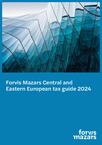
Forvis Mazars Central and Eastern European tax guide 2024
This guide, which has grown from covering 15 countries in 2013 to 25 in 2024, delves into a broad spectrum of tax issues, focusing on corporate income taxation, transfer pricing, employment, and sales taxes.
The 2024 guide offers a detailed analysis of tax regimes across a range of countries including Central and South-Eastern Europe, Germany, Austria, Moldova, Ukraine, the Baltic States, and for the 2nd time, Central Asian countries such as Kazakhstan, Kyrgyzstan, and Uzbekistan.
In the first section, the tax systems of the CEE region are presented country-by-country, based on data provided by the relevant Mazars offices. The end of this guide contains summary tables that allow side-by-side comparisons of the relevant tax environments.
The primary aim of the publication is to allow for comparisons to be made between the fundamental factors of competitiveness in the region.
Key findings:
- The global minimum tax introduces a new standard for multinational taxation.
- Digitalization in tax systems is enhancing transparency and compliance globally.
- Significant disparities in tax rates and competitiveness indicators across the CEE region.
We hope and trust that our readers will find this summary useful and inspiring. Please visit the interactive online platform of the Forvis Mazars CEE Tax Guide 2024:
Forvis Mazars Central and Eastern European Tax Guide 2024
and read the press release in which Kinga Baran, partner at Forvis Mazars in Poland, comments on the key issues for Poland in relation to the Forvis Mazars Central and Eastern European Tax Guide 2024.
Download the guide below.
Contact





